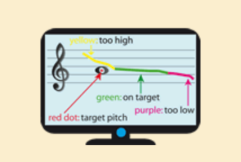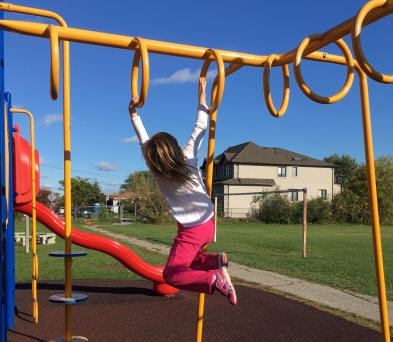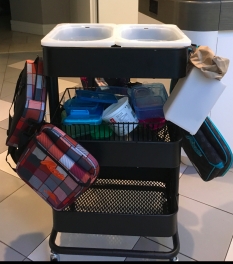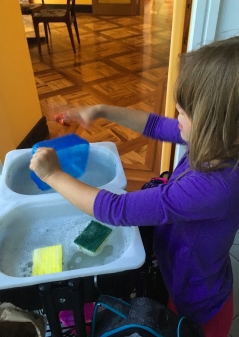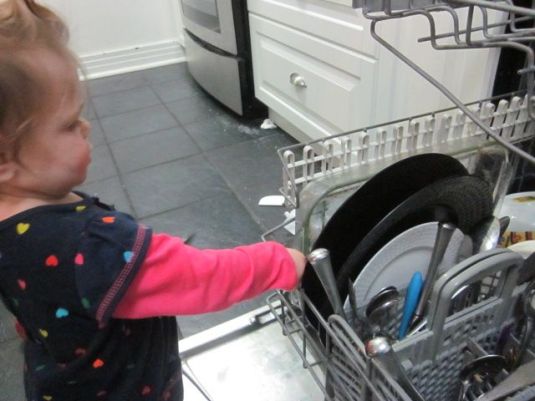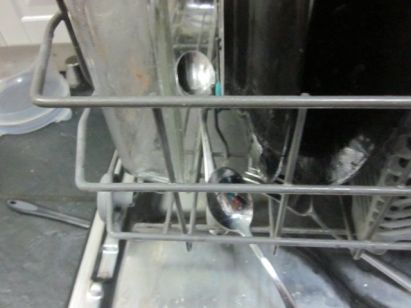We have a toddler shabbat program at our school now. Like the dozens of other toddler shabbat programs in Toronto, this one gives very young children – accompanied by their parents – the opportunity to set the Shabbat table, say the blessings, enjoy some challah and grape juice, and sing with friends. The children also have about thirty minutes of time to work with some very basic Montessori materials.
It is during this work period that I’ve been fascinated by the contrast between how most of the parents interact with their children, and how the Montessori-trained staff do.
Constant narration
In the current parenting culture, we seem to believe that we have to talk at our children nonstop. This used to irritate me when people did it to my kids, although I couldn’t articulate why other than a vague comment that “it’s insulting to a kid’s intelligence when you make their every experience verbally explicit.” Honestly, many experiences in life are more potent when you just shut up and experience them. Right?
Montessori philosophy pretty much agrees with me on this one (and it’s about time I was right about something, because so far today I’ve been wrong about many, many things. Just ask my four-year-old.) The child is supposed to learn from working with the materials, not from listening to an adult describe said work. When the adult comments or exclaims on the child’s efforts, they shift the focus from the work to themselves, breaking the child’s concentration.
Praise
Oh, I could write a book about the evils of constant praise, but many people already have. May I just say that I hate it? In a single afternoon, many weekends ago, I heard the following:
- “Good waiting, you guys.” (I figured the fact that waiting patiently will get you a snack was reinforcement enough, but some parents apparently disagreed.)
- “Good using your words!” (again, isn’t the reward of using your words that people understand and respond to you?)
- “Wow, great jumping!” (It’s a bouncy castle. Kids love to jump in those. Just what was this parent hoping to achieve by praising something that the kid does – and enjoys – naturally?)
- “Good eating snack, everybody!” (Has it come to this? We’re praising our kids foreating? You have got to be kidding me.)
Why exactly do we praise kids for every single thing they do? And what do you think happens to kids when they grow up and discover that nobody is going to praise them for taking out the garbage, showering, or fulfilling their job description?
The Montessori attitude seems to be that self-esteem comes from achieving mastery. Of course, praise that flows naturally from a place of delight with a child’s efforts is always okay. But when giving positive feedback, Montessorians generally stick to the facts, as in, “Wow. You poured water into all six glasses and didn’t spill a drop!” or, “You read that whole book without stumbling over the hard words.”
Can I just say, on a personal note, that I feel really validated by this approach? I want my kids to have self-esteem because they know that they are competent, capable, and talented – not because their mom thinks they’re cool.
Respect
Sure, we pay lip service to respecting our kids, but do we really? I know that I fail on this count multiple times a day, rushing them along when they actually need to finish what they’re doing, etc. But do we even respect the importance of what we believe our kids should be doing?
That sounded convoluted. Sorry. Maybe I’ll just skip to the anecdote.
When the mothers (and they are all mothers, although fathers are certainly invited and welcomed) arrive with their toddlers, the children immediately gravitate to the Montessori materials and begin working. What do the mothers do?
Oh, come on. Guess.
Yep. They talk. Loudly. About everything from their kids to their clothes to what’s for dinner. And this feels okay, because the kids are doing what they’re supposed to do, and the moms are doing what moms are supposed to do.
It would be okay in any other drop-in setting, in the sense that nobody would think to ask the moms to stop talking while their children played. But imagine that people kept coming into your workplace while you were trying to concentrate on an important project. And imagine those people, while not demanding your attention, were conversing loudly about things that had absolutely nothing to do with you and your work. Wouldn’t you stick your head up and say, “Excuse me, but I’m trying to work here!”? Wouldn’t you expect them to respect your right to a quiet workplace?
Montessorians respect children’s work, including their need for an appropriate workspace, materials, and yes, silence. We can talk loudly while the children play because they’re “just playing.” But if we take into account all the skills that our children are developing when they work so intently with the Montessori materials, it very quickly becomes very clear that we need to respect and support their work. And that means keeping the environment conducive to focus and attention.
Expectations
I often (about five times a day) say that the key to happiness is lower expectations. It’s true inasmuch as expecting my house to be a mess and at least one of my kids to be unhappy at any given moment helps me to face the chaos that is parenting with my sense of humour intact. And yet, my time observing the toddler program has reminded me that we (as a society) place very low expectations on young children.
Over the six-week program I’ve heard mothers exclaim “I had no idea s/he’d be able to do that!” over the following:
- a fifteen-month-old using ice tongs to transfer pom-poms from one bowl to another… for upwards of fifteen minutes
- five toddlers, all under the age of two, resisting the urge to drink their grape juice until after the blessing was said
- a child (again, under the age of two) carrying a ceramic bowl containing water, without spilling or dropping it
And those are just the things the mothers exclaimed about. Other things, like the fact that all the toddlers drank from glass cups without any being broken, were taken for granted within the classroom but might surprise non-Montessorians.
In short, very young children are capable of a lot more than we think they are. My kids surprise me with this every day: yesterday K insisted on carrying a cafeteria-style tray laden with food – and real china plates – to our table at Aroma. I said “no” again and again until she wore me down with her insistence that she could do it. She did it. No tipping, no spilling. I was amazed. I also apologized for doubting her.
All of this makes me wonder, what else are our children capable of?
Imagine how the landscape of parenting in North America would be different if every parent allowed their child the time and space to focus on their interests, respected the child’s “work” (be it play, reading, or practicing new skills,) and had high expectations of their child’s ability to function competently in the world. How would our children be different? And how different would our schools look?
I can only imagine. Well, except for that last question. The answer to that is staring me in the face every morning at 9 a.m.



What abilities have your children surprised you with? Do you tend to praise? Over-praise? Or under-praise (like me)? Please share your thoughts by leaving a comment.
